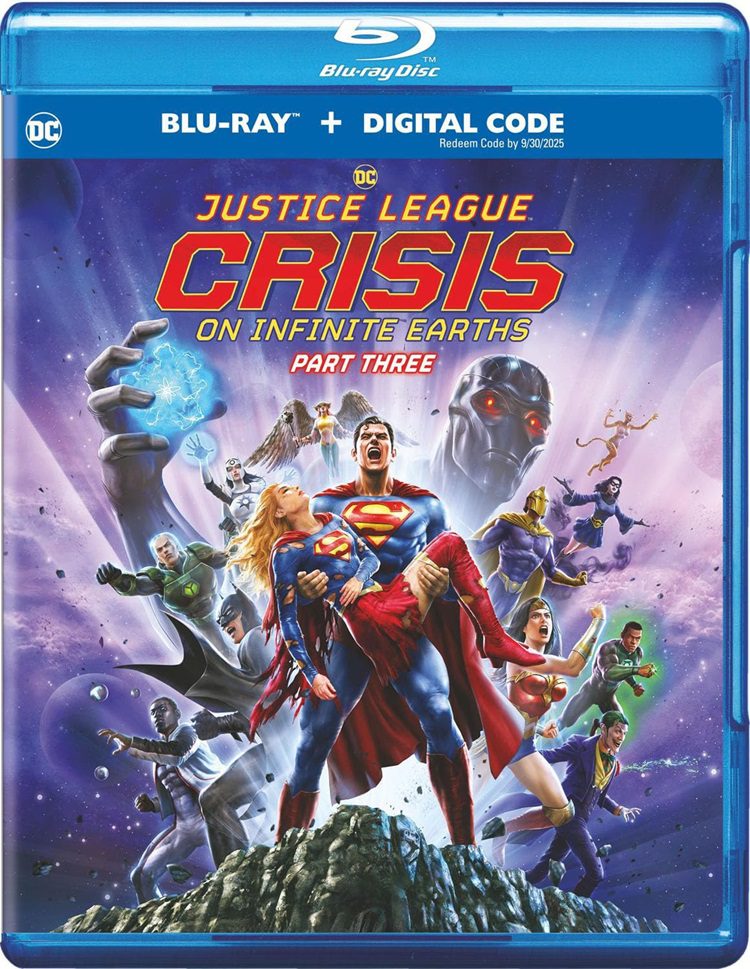
Based on DC Comics’ 12-issue miniseries Crisis on Infinite Earths (1985) written by Marv Wolfman and pencilled by George Pérez, which was previously adapted in the Arrowverse as a five-part TV miniseries (2019), Justice League: Crisis on Infinite Earths Part Three concludes the trilogy of animated films that adapts the classic story that forever altered the DC Multiverse.
Buy Justice League Crisis on Infinite Earths Part Three Blu-rayAs with Part Two, there’s no “previously on” to review what’s taken place, so the story opens with the heroes battling a giant creature. the Anti-Monitor. Then cuts to Supergirl having killed the Monitor. Somehow, his ship is powered by his damaged body, and it transports a number of worlds away from the Anti-Monitor into the Bleed, an unstable dimension outside the Multiverse.
Eight months have gone by. People on the different planets are trying to survive with their limited resources. It’s a little harder on Earth-1 when dinosaurs arrive through an energy wave. It’s a fun sequence of action and destruction as the heroes, including a group of WWII soldiers known as the Losers, fight dinosaurs, but it seems an unnecessary tangent in the greater story.
Since “the Bleed is tearing itself apart,” Lex Luthor strives to obtain information about the Anti-Monitor in order to fight it. To do that, he reveals to the Anti-Monitor where the Bleed is, and every time it appears, it destroys another planet. Lex justifies this since the Anti-Monitor was going to find them anyway.
After some discussion comparing stories, the heroes realize the Flash is instrumental in what has been happening. They seek out John Constantine, who is determined to be older than the Multiverse. Through astral projection, Batman and Constantine see into the past when there was just one Earth and it was destroyed by Darkseid. Constantine sends the Flash further back in time to stop Darkseid. However, Constantine’s plan to kill Darkseid, a creature who exists as a point in time, caused two universes to form, and more universes formed from there. The universe couldn’t handle being stretched into a Multiverse. The Anti-Monitor was the response, like an antibody.
The script presents interesting cosmological concepts as it reckons with the Multiverse and time travel. However, things are righted much too easily. Upon the disintegration of the Bleed, our main heroes are assisted by Martian Manhunter and others aboard Warworld, which just happens to be standing by, and didn’t explode as it appeared. And to finally put things right, the Miracle Machine is sought, a special device that basically works like magic. With it, a new Monoverse is created, with the multiple characters entering it not knowing the future, setting up the next wave of DC Animated movies.
Crisis on Infinite Earths Part Three does a very good job explaining what has happened and also juggling so many characters and storylines. There are a lot of fun surprises for longtime DC Comics fans. Seeing characters make sacrifices to right things is noble, but they would have been better served if some of the plot points weren’t so heavy-handed.
The video has been given a 1080p/MPEG-4 AVC encoded transfer displayed at an aspect ratio of 1.78:1. Like the previous two parts, the colors pop in bold hues, bringing to mind the way the look in comic books. Blacks are inky and whites are accurate. Details in the character design and settings are apparent. The audio is available in DTS-HD 5.1 Master Audio. The clarity of the dialogue is consistent. The surrounds offer composer Kevin Riepl’s score and the sound effects of the action.
The Special Features are:
- A Multiverse of Inspiration (9 min) – Members of DC team talk about the various multiverses included in this miniseries.
- John and John: Stewart and Constantine (8 min) – The same team talk about the two characters.
Although I remain puzzled by the release strategy, Crisis on Infinite Earths needed its plotlines streamlined and more work done on the script to tell such an epic story. Part of the problem is that in the comics it was decades in the making while in this Tomorrowverse, viewers haven’t spent as much time with the characters to be as invested. The high-definition presentation is pleasing, but would have liked more extras, especially considering this is the final part.